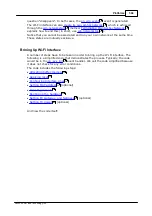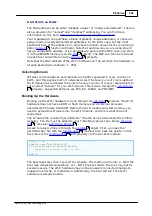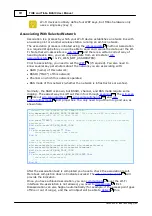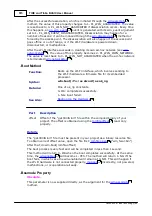
508
Platforms
©2000-2008 Tibbo Technology Inc.
A bit of info on MACs
The MAC address can be either "globally unique" or "locally administered". There is
also a provision for "unicast" and "multicast" addressing. You can find more
information on this here:
http://en.wikipedia.org/wiki/Mac_address
Your organization can purchase a block of globally unique addresses, or choose to
assign random locally administered addresses. In the latter case, set the most
significant byte of the address to 2, and choose random values for the remaining 5
bytes (
function will help). Note that each device you are using should
have a unique MAC address. It is a good idea to generate the MAC once, and store
it in the EEPROM memory (see the
object). The MAC can then be retrieved
on each boot and written into the
property.
Note that the MAC address of the Wi-Fi interface can't be set when the hardware is
already booted (wln.enabled= 1- YES).
Selecting Domain
Wireless communications and channels are tightly regulated in every country on
Earth, and this applies to Wi-Fi networks as well. Not every one of 14 pre-defined
Wi-Fi frequencies is allowed to be used in every country. It is your responsibility to
set a correct "domain" for your Wi-Fi device. This is done through the
property. Supported domains are FCC, EU, JAPAN, and "OTHER".
Booting Up the Hardware
Booting up the Wi-Fi hardware is done through the
method. The Wi-Fi
hardware does not have a ROM or flash memory and its internal processor
executes its firmware from RAM. Before the Wi-Fi module can start working, you
need to upload this firmware into the Wi-Fi module, and this is what wln.boot
really does.
The firmware file is called "ga1000fw.bin" (the file can be downloaded from Tibbo
website). The file must be added to your Tibbo Basic project as a binary
).
Access to resource files is through the
object. First, you open the "
method, then pass the pointer to this
file (value of the
R/O property) to the wln.boot method:
'boot it up
romfile.open("ga1000fw.bin")
If
wln.boot(romfile.offset)=NG
Then
'something is wrong, react to this
...
End
If
The boot takes less than 1 second to complete. The method will return 0- OK if the
boot was completed successfully, or 1- NG if the boot failed. The boot may fail for
several reasons. The Wi-Fi hardware may not be powered, connected improperly,
mapped incorrectly, or malfunction. Additionally, the boot will fail if the Wi-Fi
hardware is already booted.
211
380
520
518
515
20
128
375
379
378






























